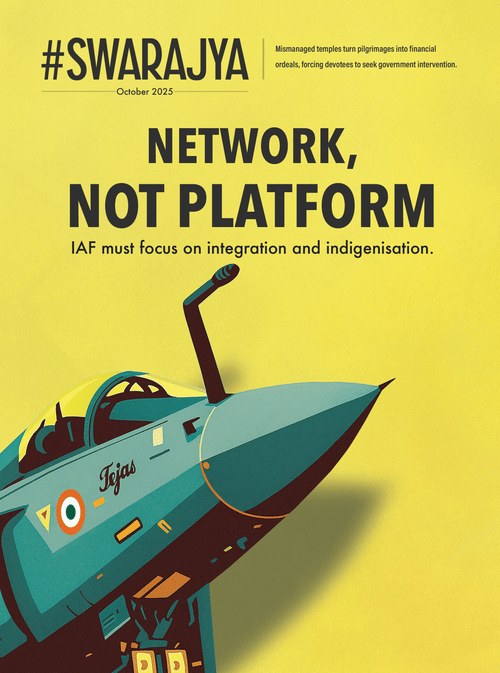Infrastructure
Affordable Roads, Secure Returns? The Trade-Off Behind The Annual Pass For National Highways
Sethuraman
Sep 26, 2025, 04:16 PM | Updated 04:16 PM IST
Save & read from anywhere!
Bookmark stories for easy access on any device or the Swarajya app.


On 15 August 2025, the Ministry of Road Transport and Highways (MoRTH) announced the introduction of “an annual pass for private vehicles—cars/vans/ jeeps”—plying on India’s National Highways (NH).
The annual pass is worth Rs 3,000 and has a cap of 200 trips translating to Rs 15 per trip.
As per official sources, around 1.4 lakh users bought the annual pass on Day 1 itself with 1.39 lakh transactions.
While the move is expected to bring relief and convenience to millions of NH users, it raises equally important questions on revenue models and investor confidence in the road sector.
Mobility, Revenue And Investor Confidence
Under the Asset Monetisation Plan, National Highways are increasingly managed by private developers, Infrastructure Investment Trusts (InvITs), and Toll-Operate-Transfer (ToT) operators. MoRTH has assured that private operators will be compensated for revenue loss under the annual pass scheme and has notified a compensation framework. The current framework covers a period of three months and will be reassessed thereafter.
But who really gains, and where do risks lie? What is the daily traffic count of cars, vans, and jeeps on national highways, and how does it vary across regions and toll plazas?
Vehicle traffic data indicates that private vehicles in this category account for around 20 per cent of total car/van/jeep traffic (ranging from 15–30 per cent depending on the toll plaza).
Just 13 Per Cent of Toll Plazas Drive Almost Half the Revenues
Of India’s 1,046 toll plazas, only 137 record daily car/jeep traffic above 10,000. These 13 per cent of plazas generate 47 per cent of all daily traffic in this category and also 47 per cent of toll revenues.
This implies that the annual pass will disproportionately affect a small set of very high-volume corridors while leaving most plazas largely unaffected.
Regional Hotspots
There are 21 toll plazas with average daily traffic exceeding 25,000 cars/jeeps/vans. Haryana alone accounts for eight of the busiest, mostly encircling Delhi’s NCR—Bhagan, Badarpur-Faridabad, Kherki Daula, and Panipat stretches.
Karnataka follows with four, clustered around Bengaluru (Devanahalli, Bangalore–Nelamangala, Electronic City, Hoskote). Tamil Nadu and Uttar Pradesh each host two; Maharashtra has just one (Khed–Shivapur).
At the state level, Rajasthan has the highest number of toll plazas (150+), yet none exceed 25,000 daily cars/jeeps. This shows that volume, not toll plaza count, drives revenues. Four of the top 21 plazas are located on NH-1, and three on NH-4.
Concession Models
Of the 21 busiest toll plazas, 20 are developed under the PPP model, with 18 operating under BoT-Toll—where the concessionaire bears the collection risk.
Seven of these assets are managed by InvITs and ToT operators. Cube Highways manages three, Vertis Infrastructure Trust two, and Nxt-Infra Trust and IRB InvIT one each.
Toll Plazas That Matter More
Devanahalli (Karnataka) tops the country with 75,740 cars/jeeps daily, where the cars and jeeps account for 92 per cent of traffic and 78 per cent of revenue.
Bhagan (Panipat, Haryana) sees 49,217 daily cars/jeeps, contributing 76 per cent of traffic.
Badarpur-Faridabad (Haryana) reports 94 per cent of vehicles as cars/jeeps.
In terms of tariffs, 10 of these 21 plazas charge more than Rs 100 for a single journey compared to Rs 15 per trip under the pass. The tariff variation is striking: Chandi Mandir (Rs 25) at the lowest, and Ladowal (Rs 230) at the highest.
The Road Ahead
The Annual Pass for National Highways may bring welcome relief for motorists but risks intensifying congestion on the busiest corridors. The government’s data-driven compensation framework is a pragmatic step, yet the fiscal burden—likely running into thousands of crores—cannot be ignored.
For highway concessionaires and listed InvITs, the impact will be uneven: a handful of high-volume toll plazas will bear the brunt of lost revenues, while many others remain largely unaffected.
This unevenness highlights the central tension in India’s tolling model. On one hand lies the imperative of making road travel more affordable and convenient for citizens; on the other lies the need to preserve investor confidence in an asset class that has become a cornerstone of infrastructure financing.
Globally, the most resilient road-pricing regimes achieve a delicate balance between these objectives. For India, the Annual Pass is more than a tariff tweak— indicating whether its tolling framework can evolve to align the interests of motorists, the state, and private capital in a way that sustains both mobility and investment.
Sethuraman is founder, Roads India.





